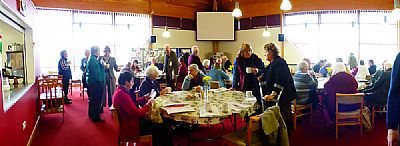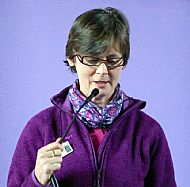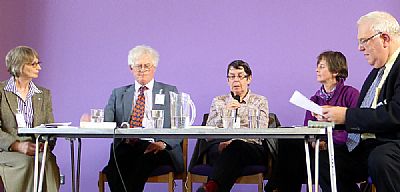Study Day Report
On Saturday April 4th 2014, 64 delegates from as far away as Perth and Edinburgh joined members of the Inverness and Black Isle U3A to take part in a study day and discussion on the future of the Highland Landscape at Smithton Free Church, Inverness.

U3A Delegates in the cafe at Smithton Free Church
The first speaker was Professor Richard Oram, of Stirling University, who began proceedings by giving an overview of the way in which peoples’ perceptions of the Highland Landscape and its management have evolved over the last 300 years.
The main thrust of Professor Oram’s presentation was that while the popular image of the Highlands is one of an unchanging, untouched, unspoilt natural wilderness in reality the area has been inhabited, valued and exploited by man since the end of the Ice Ages.

Professor Richard Oram
From earliest tmes man’s settlement of the Highlands has been subject to a variety of environmental pressures and particularly that of climate change. Despite this archaeological and documentary evidence shows that with the introduction of agriculture the uplands were divided into social and economic units capitalising upon the natural and mineral wealth of the upland woodlands, lochs and grasslands in a rational and sustainable fashion.
Seventeenth and eighteenth century travellers, however, saw the uplands as being wild and barbarous in complete contrast to the order and fruitfulness of the lowlands. In keeping with the philosophy of the times land was seen as the gift of God and not to take this gift and make it bountiful would, in itself, be an ungodly act. Improving landlords, through the introduction of new forms of agriculture, new settlements and tenants with an incentive to get the best return from the land, sought greater economic and political security. Replacing black cattle with sheep, consolidating runrig into croft units and the introduction of new methods of husbandry from the lowlands, however, had the opposite effect and over time farming in the uplands became uneconomic and unsustainable.
New tensions arose as the ‘Romantics’ of the nineteenth century, such as Scott and the Wordsworths, disregarded the ‘improving landscape’ of Sinclair and Mackenzie and saw in the Highlands a lost world to be discovered. This was a world of primeval solitude and sublime grandeur in which the cultured, land-holding elite could explore the symbiotic relationship between man, nature and landscape through architecture, poetry, art and field sports finding its ultimate expression in the concept of ‘Balmorality’.
In the twentieth century growing numbers of urban people with leisure time to spare and a desire to explore the uplands led to further stress which revolved around the complex issues of access to the ‘wilderness’ and its preservation. The latter issue is of particular importance to the historian as by preserving what is there, and preventing development, the landscape becomes fossilised and disregards the continuum of change. Indeed, Professor Oram asserted, conservation biology denies previous human activity and removes it from the landscape.
The challenge of the twenty-first century, Professor Oram proposed, is how do we manage the Highlands for our children and their children while sustaining its value and without denying its history and character?
At present there is a growing sense of conflict between those that want to develop the Highlands and those that want time to stand still. There is a need, Professor Oram said for honest debate, to replace the state of engaged apathy that exists asking not only the obvious questions of “What do we value in the existing landscape?” and “What should we preserve?” but to also ask ourselves “What can we afford to lose?”
After a short break Fran Lockhart, John Muir Trust Property manager – Nevis, Quinag and Sandwood, outlined the vision and commitment of the John Muir Trust to the concept of ‘Wild land’ through her own work in the Northwest Highlands.

Fran Lockhart JMT
The Trust’s basic position is that wild landscapes are one of the United Kingdom’s greatest assets. They are world renowned for their scenic qualities and are intrinsically linked to national and regional culture. The planning system across Scotland and the UK, however, is failing to adequately protect our most important landscapes and wild land. The intrusion into the landscape of roads, industrial infrastructure and renewable energy schemes is significantly reducing the extent of wild land and the overall scenic quality of the landscape across the whole country.
Wild land has a special place and value within the nation’s natural and cultural capital and thus the John Muir Trust believes that wild land should be protected and managed sustainably. The process of management and protection will enhance wild land, allow people of all ages and all walks of life to benefit from the tranquillity and solitude of such places and, above all, meet the needs of the communities within wild areas to thrive without destroying the special qualities and values of such places.
Fran then went on to talk about specific aspects of her own work. In detailing the everyday activities involved in managing the properties for which she is responsible a recurring theme was that of ‘balance and improvement’.
As the landowner, the Trust has to balance the need to conserve the peatland and machair at Sandwood with the needs of local crofters who directly manage the landscape. Restoring and improving the woodland on the northern slopes of Quinag, impoverished by decades of heather burning and sheep grazing and controlling the rising numbers of red deer that overgraze and trample the delicate ancient Ardvar woodland. Many of the problems encountered at Quinag, in terms of habitat destruction by sheep and deer are also found on the Nevis Estate added to which is the need to manage the impact of over 100,000 visitors and their litter.
The morning session finished with a very personal account by Jean Urquhart of the impact that the landscape and scenery of the Highlands had on her.

Jean Urquhart MSP
After lunch delegates divided into five discussion groups to consider some of the issues raised during the morning. The groups were asked to consider these issues in the context of one particular aspect of landscape and these were those of Heritage, Industry and Energy, Landscape, Population and Tourism
The final session of the day, after tea, was a panel session, answering questions that had arisen from the discussions within the groups. The questions that the panel, (comprising Fran Lockhart, Jean Urquhart, Anne Coombs and Anthony Bryant) faced were wide ranging covering subjects as diverse as the preservation of industrial landscapes, the nature of the planning system, the role of stakeholders, creating an infrastructure for expansion and the costs associated with managing increasing numbers of tourists.

Panel Sesssion
Jean Urqhart MSP, Anthony Bryant (Inverness and Black Isle U3A,
Anne Coombs (NOSAS), Fran Lockhart (JMT),Dave Rendell (Inverness and Black Isle U3A)
The panel session itself raised a number of issues, that it has been suggested could be form the basis for further discussion and study. The two most important issues relate to sustainability and land reform. It was argued that, with regard to the loss of landscape through the quest for renewable energy, a National Energy Policy that sought to use less energy more effectively would be less exploitive of the Highland landscape. A coherent and transparent planning policy focussed on creating truly sustainable communities and an effective transport and services infrastructure would also lessen the impact of population growth, particularly along the coastal margins of region.
A significant amount of time of time was spent discussing Land Reform. Much of the land that is held to contribute to the distinctive character of Highlands is held be a relatively small number of individuals and land use change on such large estates falls outside the normal planning remit, a point raised with the Landscape Discussion Group over the issue of the creation and siting of hill tracks and large agricultural buildings. Panel members felt strongly that Land Reform, emphasising that landscapes are a shared resource, would give all citizens the sort of stake in the Highland landscape that is required if there is to be a meaningful and democratic approach to decision making about the changing character and quality of the environment.
The final point, made by several of the panel and closely related in some respects to that of Land Reform, was that the people who make most from visitors/tourists do not necessarily bear the cost of the basic services and facilities infrastructure. While it is assumed that visitors inject large sums of money into the local economy the actual cost of creating and maintaining the supportive infrastructure is met by the wider community, which may not see any direct financial benefit. To this end it was suggested that there should be a fairer way of spreading the cost of catering for increasing numbers of visitors, particularly if the profits generated by increased visitor numbers were flowing out of the region or were accrued by a limited number of individuals.
In closing, what he described as an exciting day, Chairman Dave Rendell thanked all the speakers and panel members for their input and thanked the U3A Steering Group, Roy Nelson, Nick Turner, Neil Fisher, Jacqi Elmslie, Jenny Brogden, Graham Clarke and Chris Rendell for their efforts over the preceeding months in helping plan the day. Special thanks were paid to Neiliann MacIntyre for all her unstinting efforts as secretary to the Steering Group and Charlie Anderson, the facilities manager at Smithton, for his help and to Grace Manson, the caterer, and her staff for all their hard work through the day.
Photographs by Rhonda Surman, Inverness and Black Isle U3A
